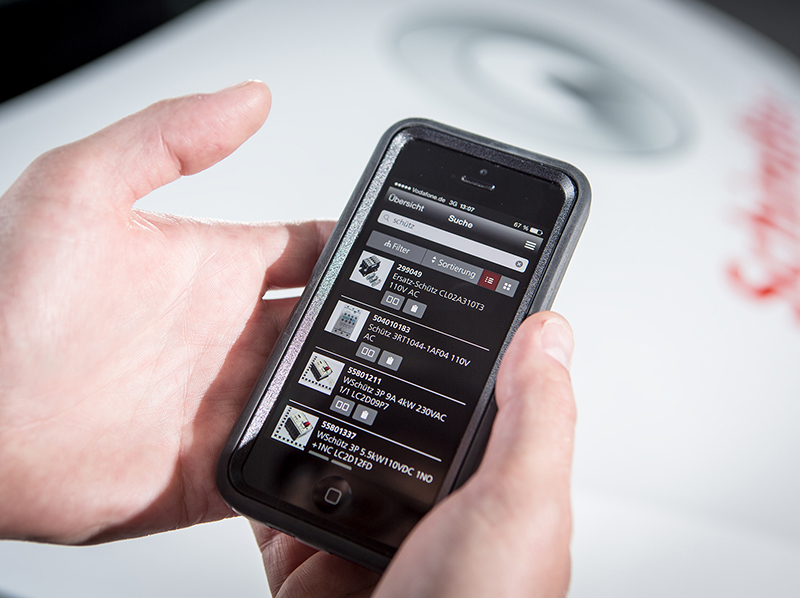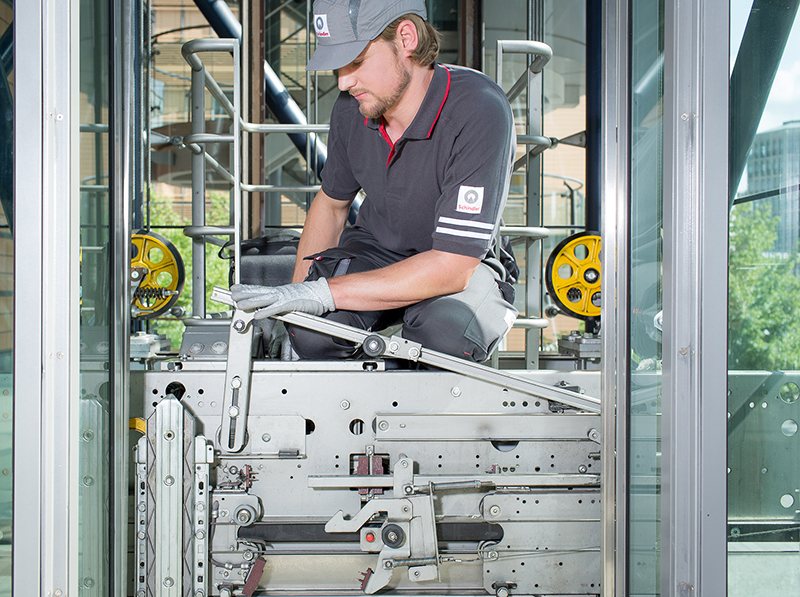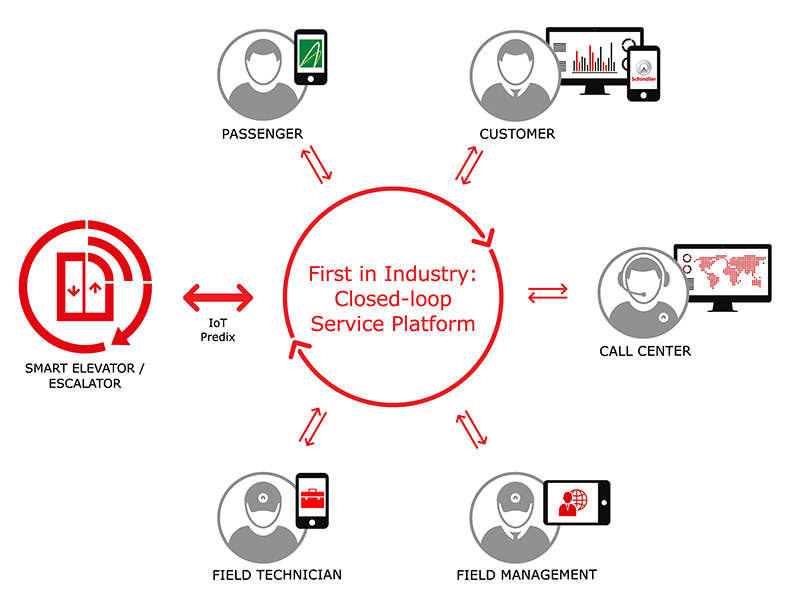Photo: © Kone

News | April 2024
Kone acquires Paca Ascenseurs
Assa Abloy has sold its lift maintenance business Paca ascenseur (Paca) in France to Kone. With this acquisition, Kone intends to strengthen its local presence in the region.

Technician with iPhone. (Photo: © Schindler)
September 2017
When we think of intelligent technology, lifts are not the first thing that enters our minds. All the same, the first cars in California are already driving autonomously.
“Smart” fridges shop independently and count calories. Heating reacts to weather forecasts and speaking furniture welcomes singles with “How was your day, sweetie?” Brave new world. You can think of this as important or threatening, but what does it have to do with lifts? This piece of equipment of all things, which has hardly changed in over 150 years and today does exactly what it did back then: travel up and down.
Today lifts and escalators of Schindler already send over 200 million messages every day to General Electric’s Predix platform. This cloud-based software makes it possible to analyse and intelligently process large quantities of data. In this way, any problems and malfunctions in the lifts can be recognised in advance and prevented.
Furthermore, this data is provided to lift technicians and customers via specially-developed apps. As a result, the service quality can be enhanced and lift down times reduced. “Our digital platform permits close linking of product, technology, process and people to the benefit of our customers,” explained Michael Nilles, Schindler’s digital director. This sounds very promising , but what does it actually mean?
 At first sight, one might not have expected a Swiss lift and escalator manufacturer that is a 140-year old family company to be one of the pioneers of Industry 4.0. But a study by Roland Berger last year confirmed just this. Schindler embarked on the road to the digital future early on.
At first sight, one might not have expected a Swiss lift and escalator manufacturer that is a 140-year old family company to be one of the pioneers of Industry 4.0. But a study by Roland Berger last year confirmed just this. Schindler embarked on the road to the digital future early on.
The IT infrastructure was harmonised and all business areas placed on a uniform platform. In the next step, every Schindler technician was equipped with an iPhone and mobile applications developed for the iOS operating system. Customers were also provided with applications to monitor their lifts in real time. This development led to services becoming more efficient and transparent today.
In the past, if a lift was defective, someone had to report this and the technician only drove to the lift once he had got the order from the manager or customer. He had to bring along manuals for the lift and the most common spare parts. However, only once he had been able to get an impression of the condition of the lift could he order the spare parts needed from the warehouse. After the repair, the process had to be documented in handwriting. A lengthy and elaborate process.
Today, a Schindler service technician begins his day by looking at his iPhone. It is his digital toolbox. There he can find the various apps that provide him with all the information that is important. His work plan and routes are designed to ensure that empty trips and diversions are avoided. This means the company’s approximately 30,000 service technicians save over 40 million kilometres driven every year. The manufacturer has calculated this corresponds to an annual saving of 4435 tons in emissions.
 However, the digital toolbox can do even more. The technician immediately sees what tools and spare parts he needs for his tour of the day. He not only gets technical information and construction plans of individual lifts – maintenance plans and histories of in part over 30-year old lifts are available too.
However, the digital toolbox can do even more. The technician immediately sees what tools and spare parts he needs for his tour of the day. He not only gets technical information and construction plans of individual lifts – maintenance plans and histories of in part over 30-year old lifts are available too.
If the technician needs help, he gets video chat support from colleagues and if he needs a spare part, he simply orders it by app. Apart from petrol and time, the toolbox above all saves one thing: paper. If you piled all the documents, manuals and documents that are now available digitally on top of each other, they would be 18 km high. Mount Everest twice on a four-inch display.
The next step in digital evolution will arrive with Internet-capable lifts. According to studies, the market of smart buildings and the building Internet of things is to double in the next four years. Even if the greatest part of this will consist of video monitoring and access systems, an increasing number of lifts will come online. Up to now, this is estimated to be precisely two percent. By contrast, in future there will probably be hardly any lifts not connected to the Internet.
 Schindler Ahead, the new digital solution of the Swiss company, goes far beyond what remote monitoring used to provide. Whereas remote monitoring usually concentrates on data displayed by serious problems like breakdowns, the Ahead Cube provides far more detailed and targeted information about the lift.
Schindler Ahead, the new digital solution of the Swiss company, goes far beyond what remote monitoring used to provide. Whereas remote monitoring usually concentrates on data displayed by serious problems like breakdowns, the Ahead Cube provides far more detailed and targeted information about the lift.
Schindler Ahead is intended to be a closed circuit, connecting lifts, customers and passengers with the Schindler customer service and technicians. The data from the Schindler Ahead Cube (computing power on the edge) and the Ahead cloud platform (big data analytics based on the GE Predix and Schindler knowledge database) is analysed and forecasts made about the lift behaviour. If action is required, the technician is automatically informed and despatched to the lift.
The field link app provides technicians with access to all the information required everywhere and they can be informed at any time. In addition, advice and instructions on the solution of the problem are provided. The technician in turn evaluates these approaches and the possibility of contributing improvements and alternatives, which are then in turn included in the knowledge data base.
Write a comment